Appreciating Gongshi: Part One – Early Standards and Scholar’s Rocks
PRIMITIVE - Friday, April 01, 2016By Glen Joffe
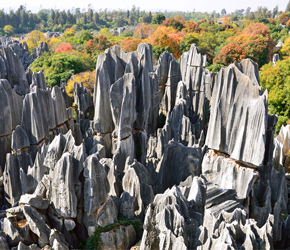 |
|
One of Lord Byron’s most famous poems, "Childe Harold's Pilgrimage," was inspired by nature; in particular, his admiration for the grandeur of the Swiss Alps. When he wrote, “Are not the mountains, waves and skies a part of me and of my soul, as I of them?” he was portraying nature in terms of beauty and adoration rather than danger and treachery; and he was professing a deep connection between himself and nature. Ultimately, Byron became a pioneer in The Romantic movement of the late 18th and 19th centuries by bringing to the forefront of European arts for the first time an appreciation of nature’s beauty. However, unbeknownst to Byron, at the time he was writing his beloved poem the tradition of finding solace and inspiration in nature had already been part of Chinese art and culture for over a thousand years, and this tradition was epitomized in evocative rocks called Gongshi.
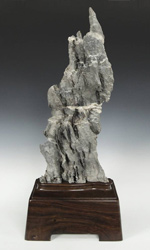 |
|
The Chinese appreciation for stone stems from a deep veneration of nature. The three prominent schools of philosophy and religion in ancient China – Confucianism, Taoism and Buddhism – all preached the importance of maintaining balance and harmony between humankind and nature. For example, early folk beliefs portrayed mountains as the abodes of gods imbued with sacred powers while towering peaks were believed to draw rain clouds necessary for good harvests. If you were connected to this aspect of nature, good things would happen. Rare minerals provided by the earth were believed to be connected to immortality. Connect yourself with these minerals and you would live longer. Whether these beliefs were rooted in reality or fallacy was less important than how they were propagated, which often came in the form of artwork.
During the Tang and Song Dynasties (618-907 AD and 960-1279 AD, respectively) landscape painting became a prominent art form. This type of art sought to capture the expressive rhythms of nature and spiritual harmony. Often, the depiction of mountains was a central theme. Concurrently, artists and scholars began to decorate their gardens with large stones of unusual shapes created entirely by the forces of nature. Known simply as garden rocks, they were admired as miniature versions of natural landscapes, although they could still be quite large. In these stones, the vastness of the world was compressed and artistic as well as spiritual appreciation was enhanced.
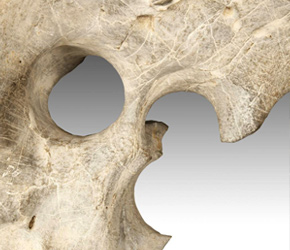 |
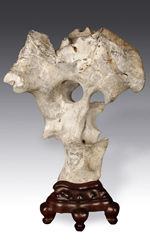 |
|
Gongshi, which literally translates as 'Spirit Stone,' are often referenced in the west as scholar’s rocks. This name is understandable, as scholars would contemplate and meditate on these stones, drawing inspiration for poems, literature, calligraphy and paintings. To a great extent, the appreciation of Gongshi as an art form began when smaller and more manageable versions of garden rocks were brought indoors to be admired in the studies of all the educated classes including scholars, officials, connoisseurs, noblemen and members of the imperial family. Once inside, they could be appreciated and contemplated in a more controlled environment.
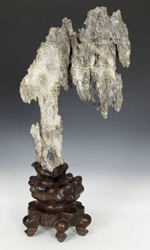 |
|
Ultimately, these stones connected viewers to a deeper and more creative understanding of the natural world; however, some Gongshi came to be regarded as much more than natural works of art. Such stones had consciousness attributed to them and actually came to be venerated. They were often referred to as 'elder brother,' 'friend,' 'master,' or given a proper name, and they were admired as much for their personality and character as their varied shapes and textures. The presence of these Gongshi could be considered more provocative than evocative, and their effect on the viewer, profound.
During the Song dynasty, collecting Gongshi became an art form in and of itself. At that time, four attributes or standards were considered important in establishing the beauty and collectability of stones, although these standards would change in later epochs. The four early standards follow:
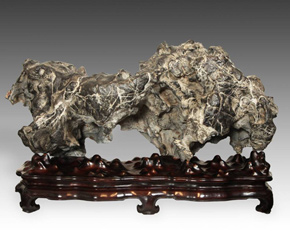 |
|
1) The first standard was shou, a reference to the slimness, delicateness and overall shape of the stone. For stones to have enhanced shou, they needed to be evocative of the landscapes found in the area now known as South China karst landscapes. This area spreads over the provinces of Guizhou, Guangxi, Yunnan and Chongqing and is considered to contain some of the most spectacular rock formations in the world. The landscape of this area is composed of sharply rising vertical towers, pinnacles, cones, natural bridges, gorges, and cave systems. Today, parts of this large area in China are considered a UNESCO heritage site; and with good reason. UNESCO describes the South China Karst as "unrivalled in terms of the diversity of its karst features and landscapes." It is easy to understand why early appreciators and collectors of Gongshi related to the terrain of this area. It is inspirational in every respect when it comes to the natural world.
2) The second standard of early collecting was zhou, which referred to the creases or wrinkles on the surface of the stone. For stones to have enhanced zhou, they needed to mimic the mountaintops, valleys, cliff faces, crevices and natural formations found in the Karst area.
3) The third standard was lou, a reference to channels or caves. Since ancient times, caves found on mountainsides were believed to be gateways into other worlds. Just as some tunnels are hidden deep inside mountains, scholars surmised that many caves and channels were similarly hidden inside Gongshi stones, out of sight and out of reach yet undeniably present and accessible only through the imagination.
4) The fourth and final standard was tou, naturally occurring perforations that expressed the openness of a stone and allowed light and air to pass through.
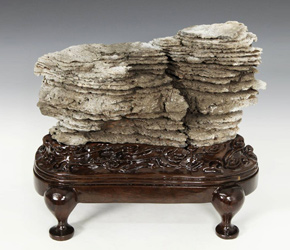 |
|
These four early standards served not only to heighten the aesthetic, but also the spiritual and philosophical qualities of stone appreciation. However, all four standards really applied to stones evocative of South China landscapes.
Although today many stones have become highly valuable and collectible as Gongshi, beginning with the Song Dynasty and extending through today, four types of stone were exceptionally prized. They are Lingbi, Taihu, Ying and Kun stones. Here are brief descriptions of these types of stones:
Lingbi stones, historically found in the Qingshi mountains of Anhui province, are fine-grained and intricately textured limestone that were buried deep in the mud. Extremely hard, lingbi stones cannot be cut with a regular knife but they produce a distinctly musical chime when tapped and were often called 'resonant rocks' in the past. Traditionally black in color with white or gray veining, there are also examples of calico lingbi stone, taupe in color, and white lingbi, which is black with pronounced white areas.
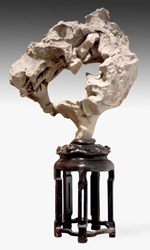 |
|
Taihu stones were originally named because they were discovered around Lake Tai, one of the three largest freshwater lakes in China. These unique stones were eroded by water currents over millions of years, leaving smoothly polished irregular structures riddled with holes and channels. Many Taihu stones have pronounced lou and are riddled with perforations. They are typically gray to white in color.
Ying stones are found in the Yingde mountain range of Guangdong Province and are formed by exposure to harsh winds and rain. Full of ragged furrows, craters and holes, the weathered surfaces evoke some of the most powerful images of memorable landscapes. Composed of marine limestone, Ying stones often have sharp edges caused by exposure to rainfall over thousands of years once the stone found itself out of the water through natural processes.
Kun stones are one of the rarest types of Gongshi, formed in old lava vents where molten rock crystallized. When all the dirt and ash is removed under running water, Kun stones are discovered to be nearly pure white quartz. They emanate from Kunshan in Jiangsu Province and today are extremely rare.
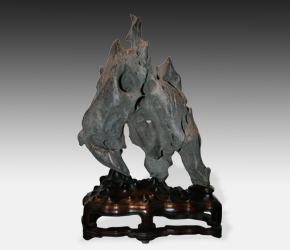 |
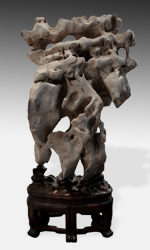 |
|
To both Chinese scholars of old and modern viewers, Gongshi represent not just a connection to nature, but a connection to nature’s unrivaled transformational powers. Expressive stones can draw the eye into cracks, crevices, miniature caves, holes and ridges. They reveal something different each time they are contemplated. Unlike the traditional notion of western sculpture, Gongshi are defined less by the space surrounding them than the world encapsulated within them. Richard Rosenblum, one of the most well known collectors of Gongshi in the West once remarked, "Gongshi are monuments to inner thought."
These remarkable stones allow viewers to discover something extraordinary and profound beyond the physical object that is entirely unique to every person. Ultimately, their appreciation is less about the stone than the sheer power of the human mind. Many animals can dream – but it appears only humans are capable of imagination; and that is the cornerstone of appreciating Gongshi.
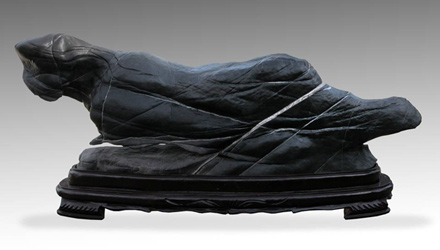 |
Download this Article: Appreciating Gongshi Part One – Early Standards and Scholars Rocks.pdf